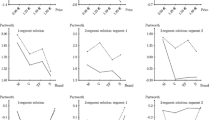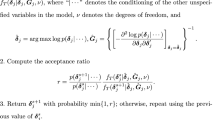Abstract
Using mixed logit models to analyse choice data is common but requires ex ante specification of the functional forms of preference distributions. We make the case for greater use of bounded functional forms and propose the use of the Marginal Likelihood, calculated using Bayesian techniques, as a single measure of model performance across non nested mixed logit specifications. Using this measure leads to very different rankings of model specifications compared to alternative rule of thumb measures. The approach is illustrated using data from a choice experiment regarding GM food types which provides insights regarding the recent WTO dispute between the EU and the US, Canada and Argentina and whether labelling and trade regimes should be based on the production process or product composition.
Similar content being viewed by others
References
American Farm Bureau (2002) Farm Bureau Blasts Europe’s Proposed Biotech Labeling Plan. AFB Press Release July 3 2002
Burton M, Rigby D (2007) Non-participation in choice models: hurdle and latent class approaches. Paper presented at ENVECON, the UK Network of Environmental Economics Conference, Royal Society, London
Casella G, George EI (1992) Explaining the Gibbs Sampler. Am Stat 46: 167–174
Chib S, Greenberg E (1995) Understanding the Metropolis-Hastings Output. Am Stat 49: 327–335
European Commission (2003) European Commission regrets the request for a WTO panel on GMOs. European Commission Press Release IP/03/1165
Gelfand A, Dey D (1994) Bayesian Model Choice: asymptotics and exact calculations. J R Stat Soc Ser B 56: 501–504
Goett A, Train K, Hudson K (2000) Customer choice among retail energy suppliers: the willingness-to-pay for service attributes. Energy J 21: 1–28
Hensher DA, Greene WH (2003) The mixed logit model: the state of practice. Transportation 302: 133–176
Inside US Trade (2003) US looking at special DSB session for first biotech panel request. August 1, 2003
Koop G (2003) Bayesian econometrics. Wiley, Sussex
Moschini, G.: (2003) Agricultural biotechnology and trade: the unresolved issues. Iowa Ag Rev 9(4) 8–10. Available at http://www.card.iastate.edu/iowa_ag_review/fall_03/article4.aspx
National Food Processors Association (2003) NFPA Press Release 20/10/03
Petitpierre A, Boisson De Chazournes L, Perrez F, Pythoud F, Mbengue M, Thomas U (2004) Trade, the environment and the international regulation of biotechnology. Special issue of EcoLomic Policy and Law, J Trade Environ Stud, Geneva, Switzerland. Available at http://www.ecolomics-international.org/epal_2004_8_snsf_unige_lawfac_buwal_research_project_int_biotech_regulation.pdf
Raftery AE (1996) Hypothesis testing and model selection. In: Gilks WR, Richardson S, Spiegelhalter D(eds) Markov chain Monte Carlo in practice. Chapman and Hall, Spiegelhalter, pp 163–188
Rekola M (2003) Lexicographic preferences in contingent valuation: a theoretical framework with illustrations. Land Econ 79(2): 277–291
Revelt D, Train K (1998) Mixed logit with repeated choices. Rev Econ Stat 804: 647–657
Rigby D, Burton M (2006) Modeling disinterest and dislike: a bounded bayesian mixed logit model of the UK market for GM food. Environ Resour Econ 33: 485–509
Rossi P, Allenby GM, McCulloch R (2005) Bayesian statistics and marketing. Wiley Series in Probability and Statistics
Ruud P (1996) Simulation of the multinomial probit model: an analysis of covariance matrix estimation. Working paper, Department of Economics, University of California, Berkeley
Sonnier G, Ainslie A, Otter T (2004) Measuring the influence of image, style and demographics on consumer brand valuations. UCLA Working Paper
Train K, Sonnier G (2003) Mixed logit with bounded distributions of partworths. Working paper, Department of Economics, University of California
Train K (2003) Discrete choice methods with simulation. Cambridge University Press, New York
Train K, Sonnier G (2005) Mixed logit with bounded distributions of correlated partworths. In: Alberini A, Scarpa R(eds) Applications of simulation methods in environmental and resource economics, Chap 7. Springer, Dordrecht, pp 117–134
Train K, Weeks M (2005) Discrete choice models in preference space and willingness-to-pay space. In: Alberini A, Scarpa R(eds) Applications of simulation methods in environmental and resource economics. Springer, Dordrecht, pp 1–16
von Haefen RH, Massey DM, Adamowicz W (2005) Serial non-participation in repeated discrete choice models. Am J Agric Econ 87(4): 1061–1076
World Trade Organization (1996) Japan—taxes on alcoholic beverages. Report of the Appellate Body. AB-1996-2
Author information
Authors and Affiliations
Corresponding author
Additional information
This paper draws work commissioned by UK Department of Environment Food and Rural Affairs (DEFRA). The views presented in this paper are those of the authors alone and should not be regarded as those of DEFRA or of individuals within DEFRA.
Rights and permissions
About this article
Cite this article
Rigby, D., Balcombe, K. & Burton, M. Mixed Logit Model Performance and Distributional Assumptions: Preferences and GM foods. Environ Resource Econ 42, 279–295 (2009). https://doi.org/10.1007/s10640-008-9227-7
Received:
Accepted:
Published:
Issue Date:
DOI: https://doi.org/10.1007/s10640-008-9227-7




